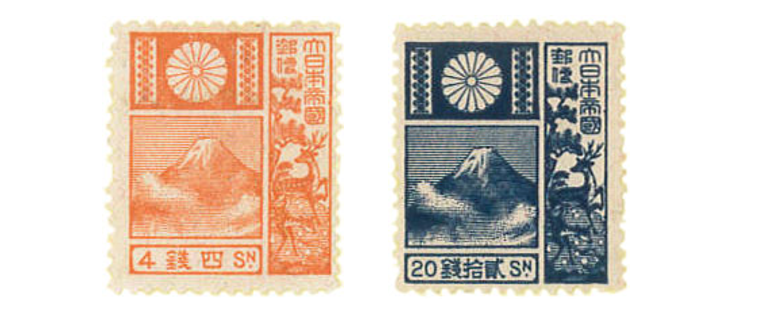歴史的背景
1922年(大正11年)、題一次世界大戦後の急激なインフレーションにより、UPU.による外国郵便値上げ(2倍)が行われた。そのため、UPU条約の統一印刷色による富士山と鹿デザインの3種の切手が発行された。印刷物用4銭(黄緑)、葉書用8銭(赤)、書状用20銭(青)である。その後、1929年(昭和4)に、UPU指定印刷色による富士鹿改色切手が発行された。
1925年(大正14)10月、外国郵便料金が値下げされた。これにより、富士鹿切手の額面が新料金と合わなくなったため、新たに1926年(大正15)に、富士山と日光陽明門、名古屋城をデザインした切手が外国郵便用に発行された。これらを「「風景切手」と呼ぶ。この後、日本は世界恐慌に巻き込まれ、アジアへ活路を求めるため、戦争への道をたどっていくことになる。
参考:小原英樹著『日本の郵便切手と近現代史抄』 2014年
今井 修著『日本切手100年小史』 1978.4.10

Historical background
In 1922 (Taisho 11), the price of foreign mail was raised (doubled) by UPU. Due to the rapid inflation after the title of World War I. Therefore, three kinds of stamps of Mt. Fuji and deer design with the unified printing color of the UPU Convention were issued. 4 sen for printed matter (yellowish green), 8 sen for postcards (red), 20 sen for letters (blue).In October 1925 (Taisho 14), foreign postage was reduced. As a result, the face value of Fuji deer stamps did not match the new price, so in 1926 (Taisho 15), a new stamp designed with Mt.Fuji, Nikko Yomeimon, and Nagoya Castle was issued for foreign mail. These are called “landscape stamps”.After this, Japan was caught up in the Great Depression and would follow the path to war in order to seek a way out of Asia.
Reference: “Japanese Postage Stamps and Modern History Extract” by Hideki Ohara, 2014.
Osamu Imai, “100 Years of Japanese Stamps”, April 10, 1978
